Taxation Assignment: Income Tax Liability Calculation and Analysis
VerifiedAdded on 2020/03/23
|11
|2024
|46
Homework Assignment
AI Summary
This assignment focuses on calculating the income tax liability of two individuals, Jordan and Cameron, detailing the process of determining assessable income, allowable deductions, and the final net tax payable. It begins with a case introduction outlining the scenario, followed by a review of relevant laws and regulations governing income tax assessment, including the Income Tax Assessment Acts of 1936 and 1997. The analysis section meticulously examines assessable income, specifying which income sources (salary, rental income, interest, dividends) are included and excluded, and why, according to the tax laws. It then delves into allowable deductions, referencing the relevant sections of the ITAA97. The assignment provides detailed calculations for both Jordan and Cameron, demonstrating how to compute their respective tax liabilities, incorporating various income sources, deductions, and tax offsets. Finally, the assignment addresses the deductibility of home office expenses, referencing Taxation Ruling 93/30 and providing advice on allowable deductions for Jordan, who works from home and employs her daughter. The assignment demonstrates a thorough understanding of income tax principles and their practical application.
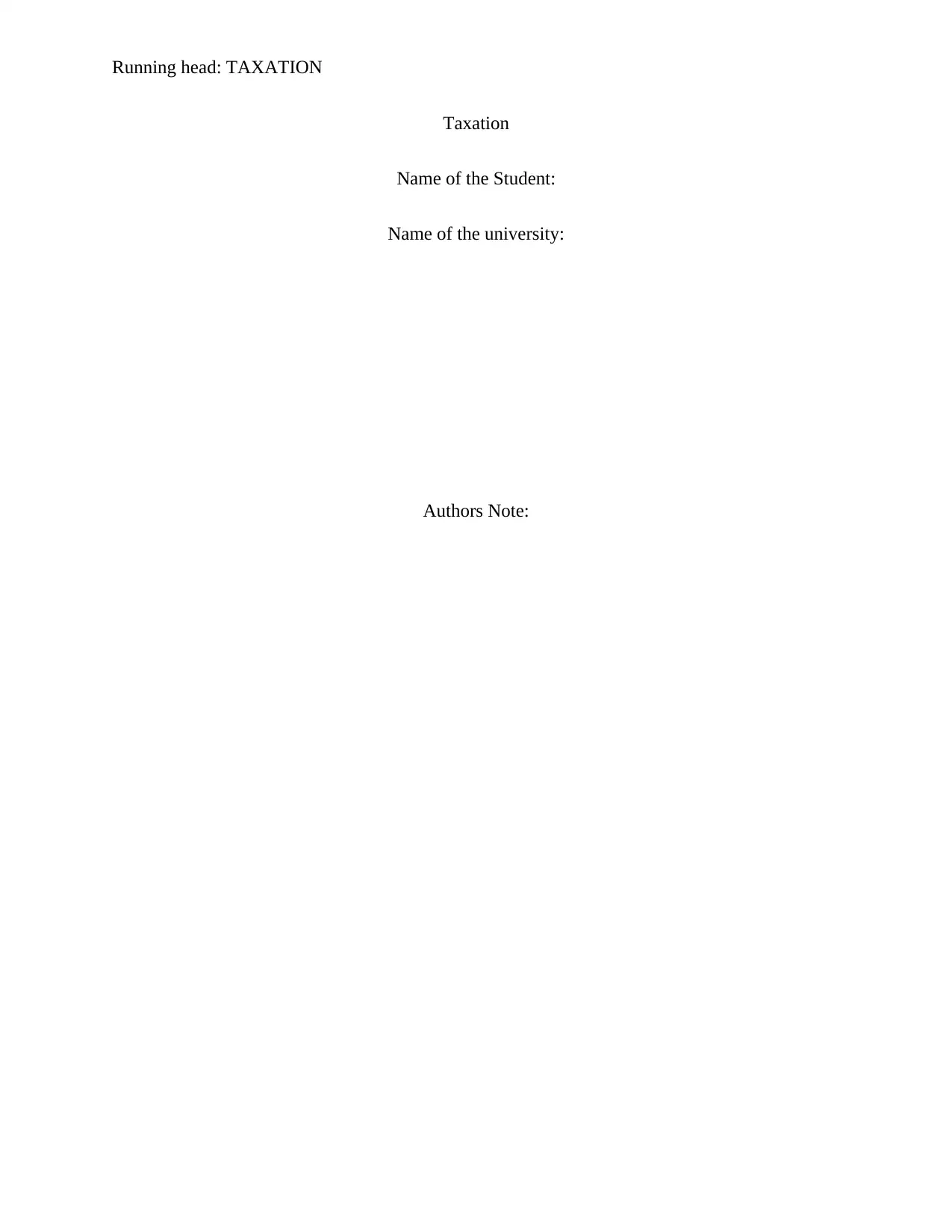
Running head: TAXATION
Taxation
Name of the Student:
Name of the university:
Authors Note:
Taxation
Name of the Student:
Name of the university:
Authors Note:
Paraphrase This Document
Need a fresh take? Get an instant paraphrase of this document with our AI Paraphraser
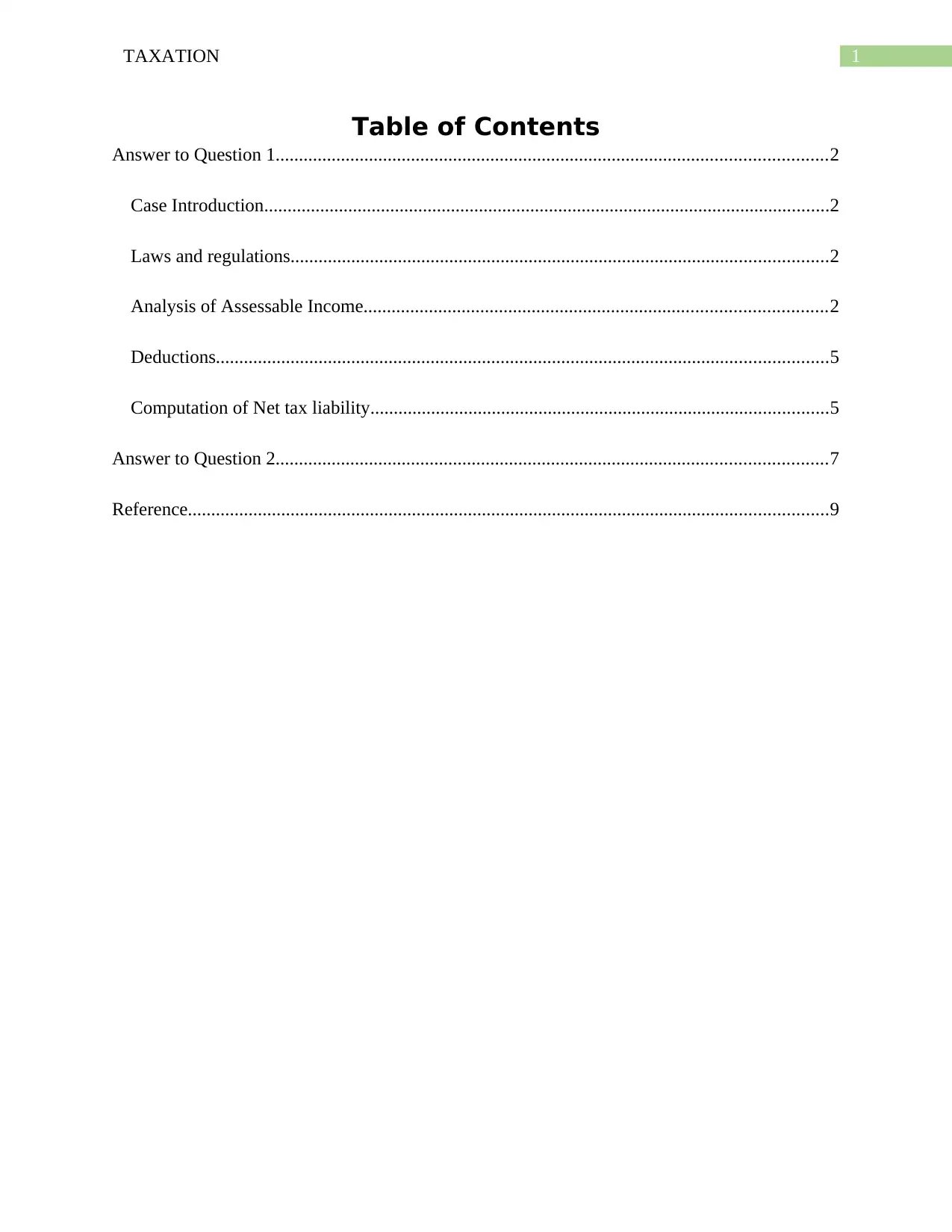
1TAXATION
Table of Contents
Answer to Question 1......................................................................................................................2
Case Introduction.........................................................................................................................2
Laws and regulations...................................................................................................................2
Analysis of Assessable Income...................................................................................................2
Deductions...................................................................................................................................5
Computation of Net tax liability..................................................................................................5
Answer to Question 2......................................................................................................................7
Reference.........................................................................................................................................9
Table of Contents
Answer to Question 1......................................................................................................................2
Case Introduction.........................................................................................................................2
Laws and regulations...................................................................................................................2
Analysis of Assessable Income...................................................................................................2
Deductions...................................................................................................................................5
Computation of Net tax liability..................................................................................................5
Answer to Question 2......................................................................................................................7
Reference.........................................................................................................................................9
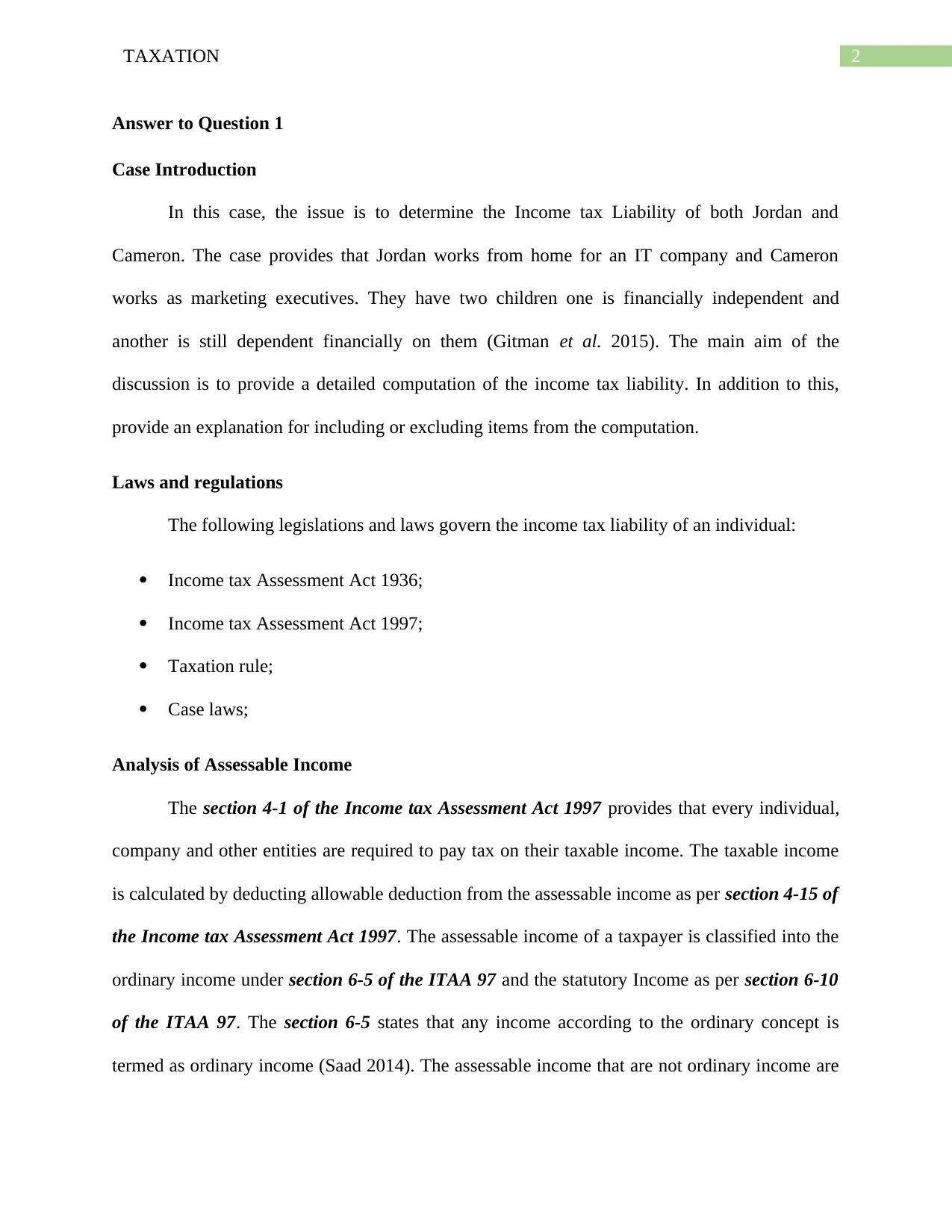
2TAXATION
Answer to Question 1
Case Introduction
In this case, the issue is to determine the Income tax Liability of both Jordan and
Cameron. The case provides that Jordan works from home for an IT company and Cameron
works as marketing executives. They have two children one is financially independent and
another is still dependent financially on them (Gitman et al. 2015). The main aim of the
discussion is to provide a detailed computation of the income tax liability. In addition to this,
provide an explanation for including or excluding items from the computation.
Laws and regulations
The following legislations and laws govern the income tax liability of an individual:
Income tax Assessment Act 1936;
Income tax Assessment Act 1997;
Taxation rule;
Case laws;
Analysis of Assessable Income
The section 4-1 of the Income tax Assessment Act 1997 provides that every individual,
company and other entities are required to pay tax on their taxable income. The taxable income
is calculated by deducting allowable deduction from the assessable income as per section 4-15 of
the Income tax Assessment Act 1997. The assessable income of a taxpayer is classified into the
ordinary income under section 6-5 of the ITAA 97 and the statutory Income as per section 6-10
of the ITAA 97. The section 6-5 states that any income according to the ordinary concept is
termed as ordinary income (Saad 2014). The assessable income that are not ordinary income are
Answer to Question 1
Case Introduction
In this case, the issue is to determine the Income tax Liability of both Jordan and
Cameron. The case provides that Jordan works from home for an IT company and Cameron
works as marketing executives. They have two children one is financially independent and
another is still dependent financially on them (Gitman et al. 2015). The main aim of the
discussion is to provide a detailed computation of the income tax liability. In addition to this,
provide an explanation for including or excluding items from the computation.
Laws and regulations
The following legislations and laws govern the income tax liability of an individual:
Income tax Assessment Act 1936;
Income tax Assessment Act 1997;
Taxation rule;
Case laws;
Analysis of Assessable Income
The section 4-1 of the Income tax Assessment Act 1997 provides that every individual,
company and other entities are required to pay tax on their taxable income. The taxable income
is calculated by deducting allowable deduction from the assessable income as per section 4-15 of
the Income tax Assessment Act 1997. The assessable income of a taxpayer is classified into the
ordinary income under section 6-5 of the ITAA 97 and the statutory Income as per section 6-10
of the ITAA 97. The section 6-5 states that any income according to the ordinary concept is
termed as ordinary income (Saad 2014). The assessable income that are not ordinary income are
⊘ This is a preview!⊘
Do you want full access?
Subscribe today to unlock all pages.

Trusted by 1+ million students worldwide
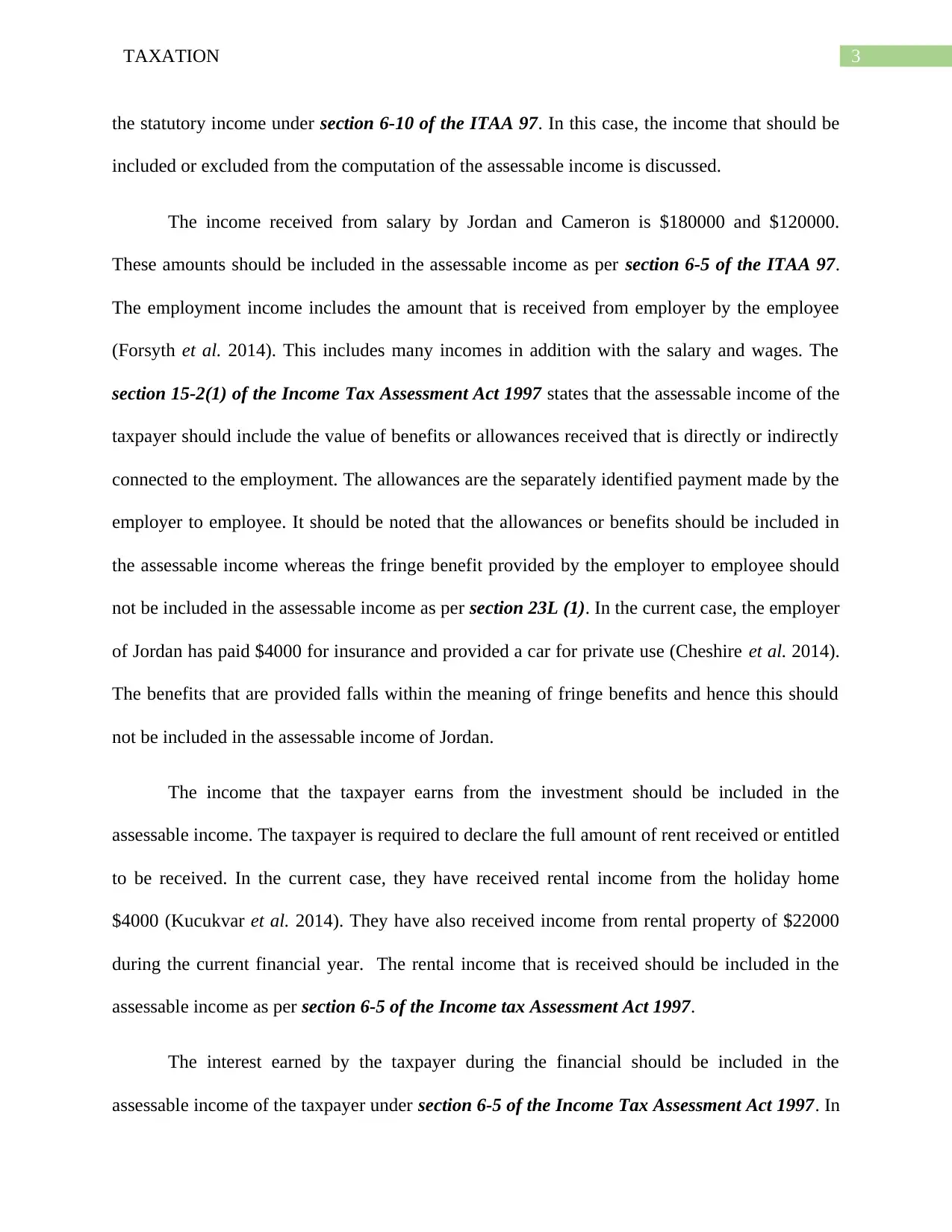
3TAXATION
the statutory income under section 6-10 of the ITAA 97. In this case, the income that should be
included or excluded from the computation of the assessable income is discussed.
The income received from salary by Jordan and Cameron is $180000 and $120000.
These amounts should be included in the assessable income as per section 6-5 of the ITAA 97.
The employment income includes the amount that is received from employer by the employee
(Forsyth et al. 2014). This includes many incomes in addition with the salary and wages. The
section 15-2(1) of the Income Tax Assessment Act 1997 states that the assessable income of the
taxpayer should include the value of benefits or allowances received that is directly or indirectly
connected to the employment. The allowances are the separately identified payment made by the
employer to employee. It should be noted that the allowances or benefits should be included in
the assessable income whereas the fringe benefit provided by the employer to employee should
not be included in the assessable income as per section 23L (1). In the current case, the employer
of Jordan has paid $4000 for insurance and provided a car for private use (Cheshire et al. 2014).
The benefits that are provided falls within the meaning of fringe benefits and hence this should
not be included in the assessable income of Jordan.
The income that the taxpayer earns from the investment should be included in the
assessable income. The taxpayer is required to declare the full amount of rent received or entitled
to be received. In the current case, they have received rental income from the holiday home
$4000 (Kucukvar et al. 2014). They have also received income from rental property of $22000
during the current financial year. The rental income that is received should be included in the
assessable income as per section 6-5 of the Income tax Assessment Act 1997.
The interest earned by the taxpayer during the financial should be included in the
assessable income of the taxpayer under section 6-5 of the Income Tax Assessment Act 1997. In
the statutory income under section 6-10 of the ITAA 97. In this case, the income that should be
included or excluded from the computation of the assessable income is discussed.
The income received from salary by Jordan and Cameron is $180000 and $120000.
These amounts should be included in the assessable income as per section 6-5 of the ITAA 97.
The employment income includes the amount that is received from employer by the employee
(Forsyth et al. 2014). This includes many incomes in addition with the salary and wages. The
section 15-2(1) of the Income Tax Assessment Act 1997 states that the assessable income of the
taxpayer should include the value of benefits or allowances received that is directly or indirectly
connected to the employment. The allowances are the separately identified payment made by the
employer to employee. It should be noted that the allowances or benefits should be included in
the assessable income whereas the fringe benefit provided by the employer to employee should
not be included in the assessable income as per section 23L (1). In the current case, the employer
of Jordan has paid $4000 for insurance and provided a car for private use (Cheshire et al. 2014).
The benefits that are provided falls within the meaning of fringe benefits and hence this should
not be included in the assessable income of Jordan.
The income that the taxpayer earns from the investment should be included in the
assessable income. The taxpayer is required to declare the full amount of rent received or entitled
to be received. In the current case, they have received rental income from the holiday home
$4000 (Kucukvar et al. 2014). They have also received income from rental property of $22000
during the current financial year. The rental income that is received should be included in the
assessable income as per section 6-5 of the Income tax Assessment Act 1997.
The interest earned by the taxpayer during the financial should be included in the
assessable income of the taxpayer under section 6-5 of the Income Tax Assessment Act 1997. In
Paraphrase This Document
Need a fresh take? Get an instant paraphrase of this document with our AI Paraphraser
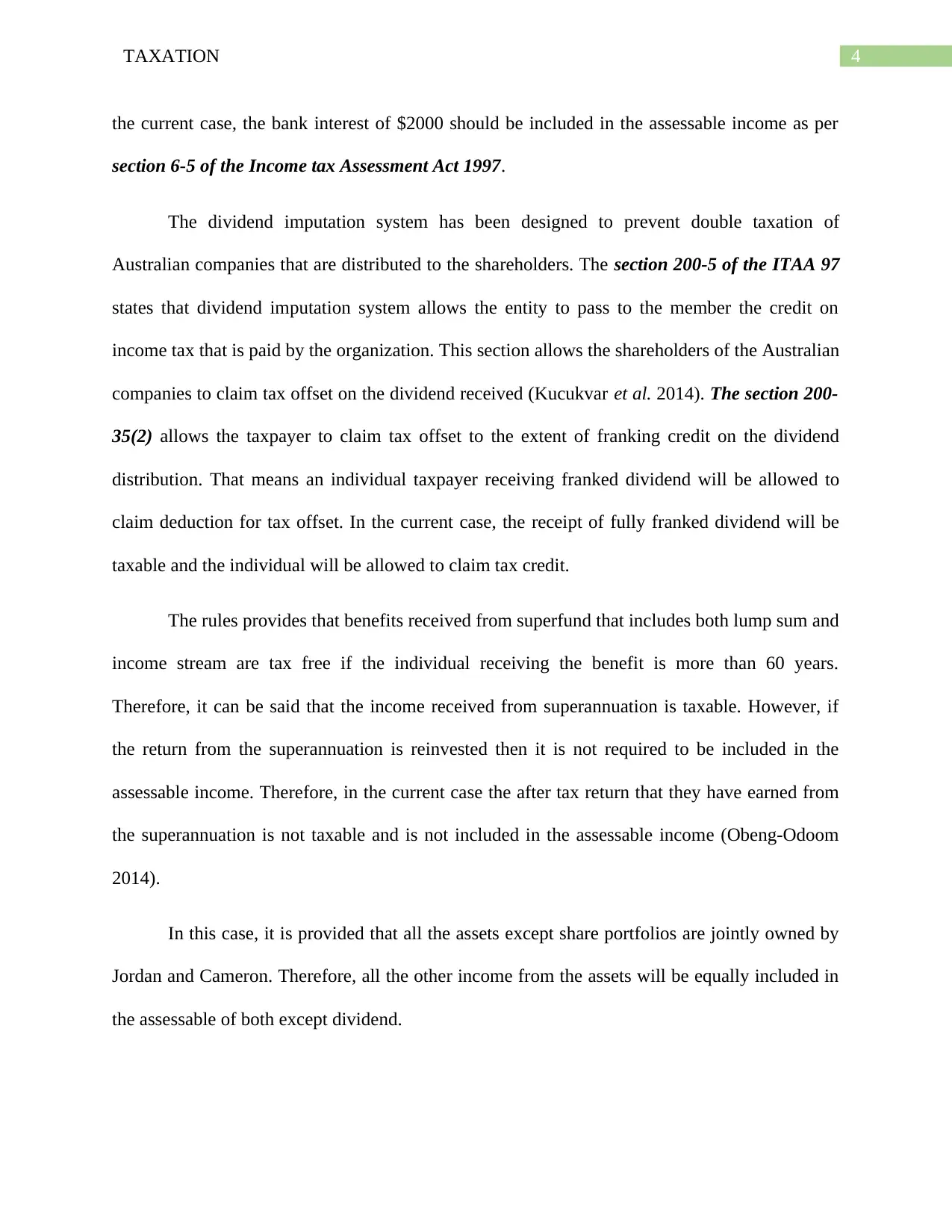
4TAXATION
the current case, the bank interest of $2000 should be included in the assessable income as per
section 6-5 of the Income tax Assessment Act 1997.
The dividend imputation system has been designed to prevent double taxation of
Australian companies that are distributed to the shareholders. The section 200-5 of the ITAA 97
states that dividend imputation system allows the entity to pass to the member the credit on
income tax that is paid by the organization. This section allows the shareholders of the Australian
companies to claim tax offset on the dividend received (Kucukvar et al. 2014). The section 200-
35(2) allows the taxpayer to claim tax offset to the extent of franking credit on the dividend
distribution. That means an individual taxpayer receiving franked dividend will be allowed to
claim deduction for tax offset. In the current case, the receipt of fully franked dividend will be
taxable and the individual will be allowed to claim tax credit.
The rules provides that benefits received from superfund that includes both lump sum and
income stream are tax free if the individual receiving the benefit is more than 60 years.
Therefore, it can be said that the income received from superannuation is taxable. However, if
the return from the superannuation is reinvested then it is not required to be included in the
assessable income. Therefore, in the current case the after tax return that they have earned from
the superannuation is not taxable and is not included in the assessable income (Obeng-Odoom
2014).
In this case, it is provided that all the assets except share portfolios are jointly owned by
Jordan and Cameron. Therefore, all the other income from the assets will be equally included in
the assessable of both except dividend.
the current case, the bank interest of $2000 should be included in the assessable income as per
section 6-5 of the Income tax Assessment Act 1997.
The dividend imputation system has been designed to prevent double taxation of
Australian companies that are distributed to the shareholders. The section 200-5 of the ITAA 97
states that dividend imputation system allows the entity to pass to the member the credit on
income tax that is paid by the organization. This section allows the shareholders of the Australian
companies to claim tax offset on the dividend received (Kucukvar et al. 2014). The section 200-
35(2) allows the taxpayer to claim tax offset to the extent of franking credit on the dividend
distribution. That means an individual taxpayer receiving franked dividend will be allowed to
claim deduction for tax offset. In the current case, the receipt of fully franked dividend will be
taxable and the individual will be allowed to claim tax credit.
The rules provides that benefits received from superfund that includes both lump sum and
income stream are tax free if the individual receiving the benefit is more than 60 years.
Therefore, it can be said that the income received from superannuation is taxable. However, if
the return from the superannuation is reinvested then it is not required to be included in the
assessable income. Therefore, in the current case the after tax return that they have earned from
the superannuation is not taxable and is not included in the assessable income (Obeng-Odoom
2014).
In this case, it is provided that all the assets except share portfolios are jointly owned by
Jordan and Cameron. Therefore, all the other income from the assets will be equally included in
the assessable of both except dividend.
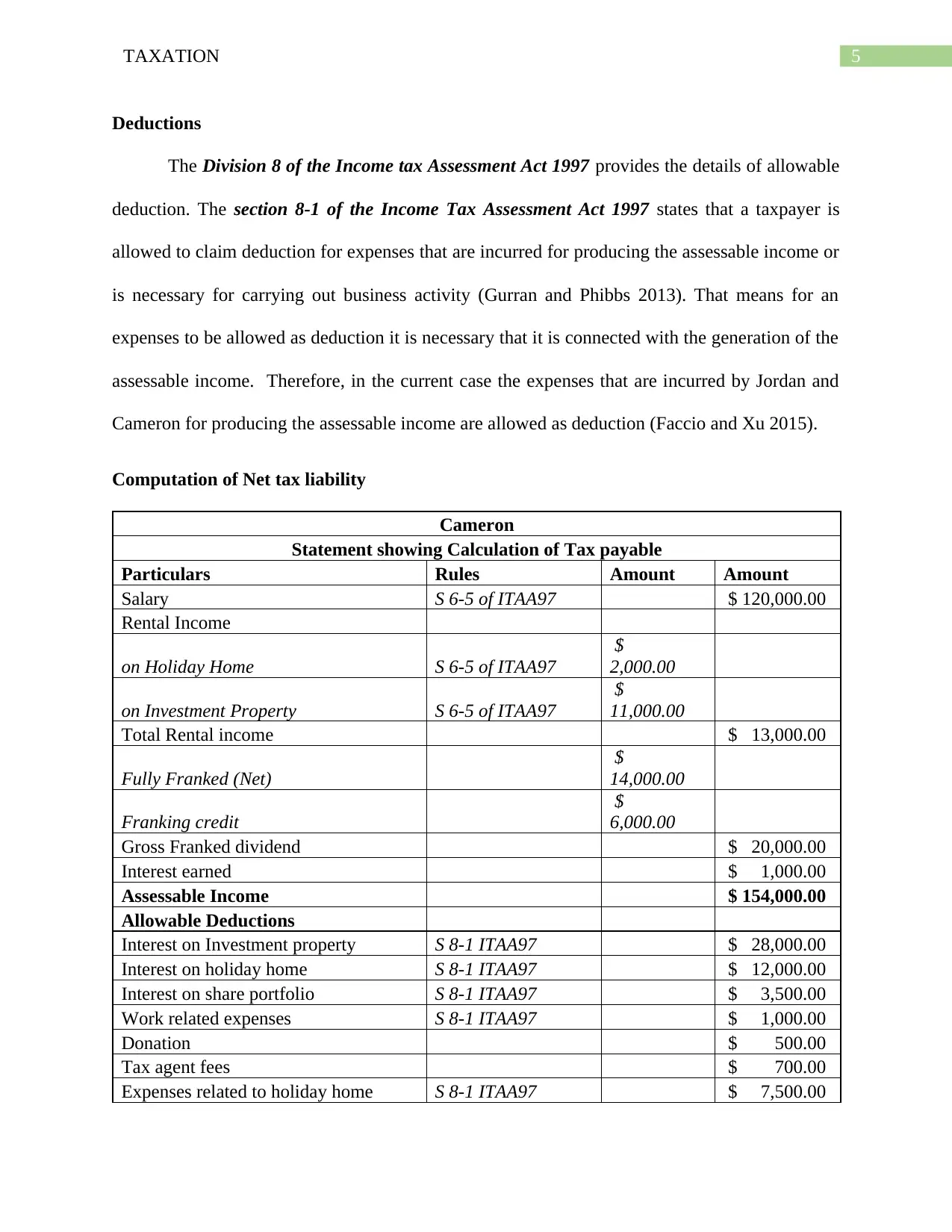
5TAXATION
Deductions
The Division 8 of the Income tax Assessment Act 1997 provides the details of allowable
deduction. The section 8-1 of the Income Tax Assessment Act 1997 states that a taxpayer is
allowed to claim deduction for expenses that are incurred for producing the assessable income or
is necessary for carrying out business activity (Gurran and Phibbs 2013). That means for an
expenses to be allowed as deduction it is necessary that it is connected with the generation of the
assessable income. Therefore, in the current case the expenses that are incurred by Jordan and
Cameron for producing the assessable income are allowed as deduction (Faccio and Xu 2015).
Computation of Net tax liability
Cameron
Statement showing Calculation of Tax payable
Particulars Rules Amount Amount
Salary S 6-5 of ITAA97 $ 120,000.00
Rental Income
on Holiday Home S 6-5 of ITAA97
$
2,000.00
on Investment Property S 6-5 of ITAA97
$
11,000.00
Total Rental income $ 13,000.00
Fully Franked (Net)
$
14,000.00
Franking credit
$
6,000.00
Gross Franked dividend $ 20,000.00
Interest earned $ 1,000.00
Assessable Income $ 154,000.00
Allowable Deductions
Interest on Investment property S 8-1 ITAA97 $ 28,000.00
Interest on holiday home S 8-1 ITAA97 $ 12,000.00
Interest on share portfolio S 8-1 ITAA97 $ 3,500.00
Work related expenses S 8-1 ITAA97 $ 1,000.00
Donation $ 500.00
Tax agent fees $ 700.00
Expenses related to holiday home S 8-1 ITAA97 $ 7,500.00
Deductions
The Division 8 of the Income tax Assessment Act 1997 provides the details of allowable
deduction. The section 8-1 of the Income Tax Assessment Act 1997 states that a taxpayer is
allowed to claim deduction for expenses that are incurred for producing the assessable income or
is necessary for carrying out business activity (Gurran and Phibbs 2013). That means for an
expenses to be allowed as deduction it is necessary that it is connected with the generation of the
assessable income. Therefore, in the current case the expenses that are incurred by Jordan and
Cameron for producing the assessable income are allowed as deduction (Faccio and Xu 2015).
Computation of Net tax liability
Cameron
Statement showing Calculation of Tax payable
Particulars Rules Amount Amount
Salary S 6-5 of ITAA97 $ 120,000.00
Rental Income
on Holiday Home S 6-5 of ITAA97
$
2,000.00
on Investment Property S 6-5 of ITAA97
$
11,000.00
Total Rental income $ 13,000.00
Fully Franked (Net)
$
14,000.00
Franking credit
$
6,000.00
Gross Franked dividend $ 20,000.00
Interest earned $ 1,000.00
Assessable Income $ 154,000.00
Allowable Deductions
Interest on Investment property S 8-1 ITAA97 $ 28,000.00
Interest on holiday home S 8-1 ITAA97 $ 12,000.00
Interest on share portfolio S 8-1 ITAA97 $ 3,500.00
Work related expenses S 8-1 ITAA97 $ 1,000.00
Donation $ 500.00
Tax agent fees $ 700.00
Expenses related to holiday home S 8-1 ITAA97 $ 7,500.00
⊘ This is a preview!⊘
Do you want full access?
Subscribe today to unlock all pages.

Trusted by 1+ million students worldwide
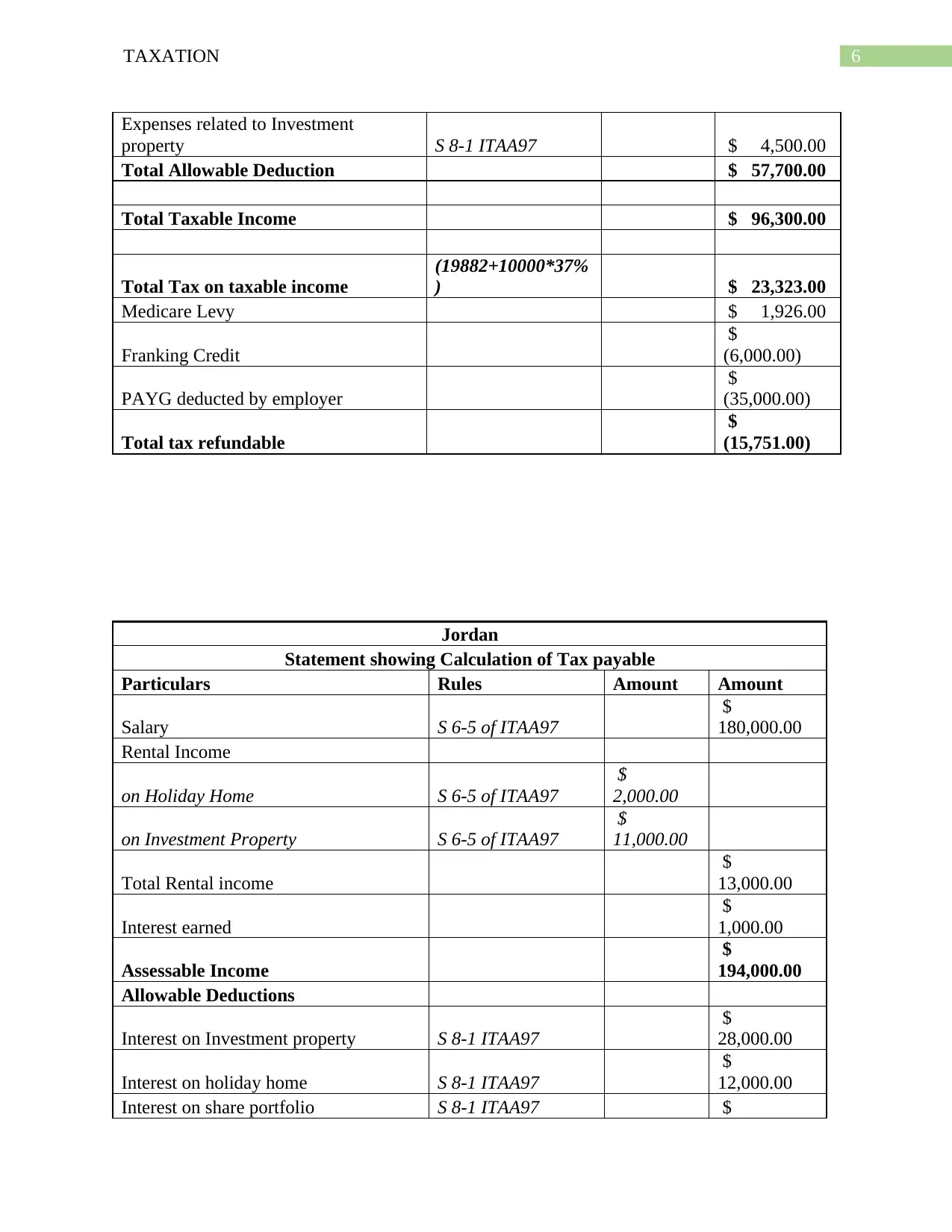
6TAXATION
Expenses related to Investment
property S 8-1 ITAA97 $ 4,500.00
Total Allowable Deduction $ 57,700.00
Total Taxable Income $ 96,300.00
Total Tax on taxable income
(19882+10000*37%
) $ 23,323.00
Medicare Levy $ 1,926.00
Franking Credit
$
(6,000.00)
PAYG deducted by employer
$
(35,000.00)
Total tax refundable
$
(15,751.00)
Jordan
Statement showing Calculation of Tax payable
Particulars Rules Amount Amount
Salary S 6-5 of ITAA97
$
180,000.00
Rental Income
on Holiday Home S 6-5 of ITAA97
$
2,000.00
on Investment Property S 6-5 of ITAA97
$
11,000.00
Total Rental income
$
13,000.00
Interest earned
$
1,000.00
Assessable Income
$
194,000.00
Allowable Deductions
Interest on Investment property S 8-1 ITAA97
$
28,000.00
Interest on holiday home S 8-1 ITAA97
$
12,000.00
Interest on share portfolio S 8-1 ITAA97 $
Expenses related to Investment
property S 8-1 ITAA97 $ 4,500.00
Total Allowable Deduction $ 57,700.00
Total Taxable Income $ 96,300.00
Total Tax on taxable income
(19882+10000*37%
) $ 23,323.00
Medicare Levy $ 1,926.00
Franking Credit
$
(6,000.00)
PAYG deducted by employer
$
(35,000.00)
Total tax refundable
$
(15,751.00)
Jordan
Statement showing Calculation of Tax payable
Particulars Rules Amount Amount
Salary S 6-5 of ITAA97
$
180,000.00
Rental Income
on Holiday Home S 6-5 of ITAA97
$
2,000.00
on Investment Property S 6-5 of ITAA97
$
11,000.00
Total Rental income
$
13,000.00
Interest earned
$
1,000.00
Assessable Income
$
194,000.00
Allowable Deductions
Interest on Investment property S 8-1 ITAA97
$
28,000.00
Interest on holiday home S 8-1 ITAA97
$
12,000.00
Interest on share portfolio S 8-1 ITAA97 $
Paraphrase This Document
Need a fresh take? Get an instant paraphrase of this document with our AI Paraphraser
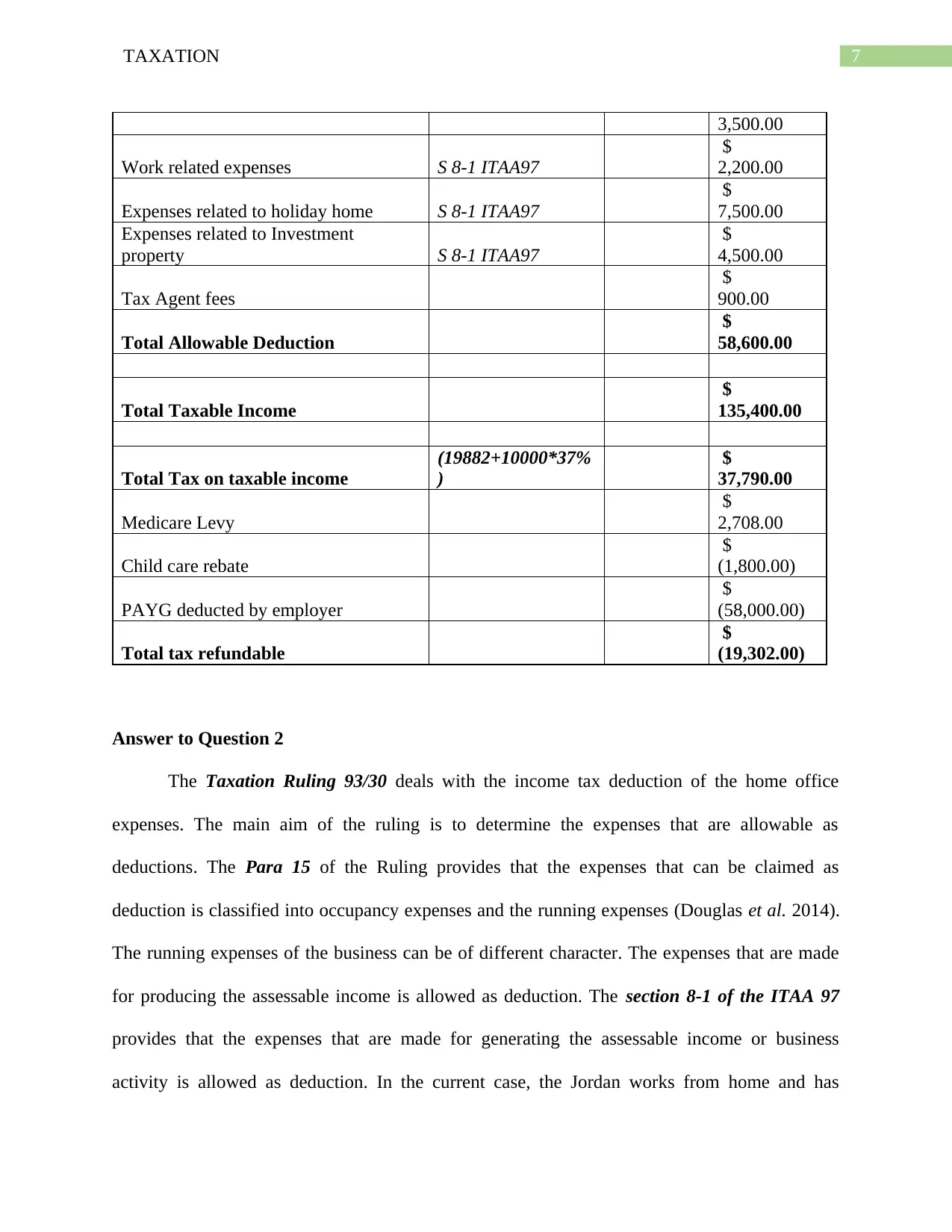
7TAXATION
3,500.00
Work related expenses S 8-1 ITAA97
$
2,200.00
Expenses related to holiday home S 8-1 ITAA97
$
7,500.00
Expenses related to Investment
property S 8-1 ITAA97
$
4,500.00
Tax Agent fees
$
900.00
Total Allowable Deduction
$
58,600.00
Total Taxable Income
$
135,400.00
Total Tax on taxable income
(19882+10000*37%
)
$
37,790.00
Medicare Levy
$
2,708.00
Child care rebate
$
(1,800.00)
PAYG deducted by employer
$
(58,000.00)
Total tax refundable
$
(19,302.00)
Answer to Question 2
The Taxation Ruling 93/30 deals with the income tax deduction of the home office
expenses. The main aim of the ruling is to determine the expenses that are allowable as
deductions. The Para 15 of the Ruling provides that the expenses that can be claimed as
deduction is classified into occupancy expenses and the running expenses (Douglas et al. 2014).
The running expenses of the business can be of different character. The expenses that are made
for producing the assessable income is allowed as deduction. The section 8-1 of the ITAA 97
provides that the expenses that are made for generating the assessable income or business
activity is allowed as deduction. In the current case, the Jordan works from home and has
3,500.00
Work related expenses S 8-1 ITAA97
$
2,200.00
Expenses related to holiday home S 8-1 ITAA97
$
7,500.00
Expenses related to Investment
property S 8-1 ITAA97
$
4,500.00
Tax Agent fees
$
900.00
Total Allowable Deduction
$
58,600.00
Total Taxable Income
$
135,400.00
Total Tax on taxable income
(19882+10000*37%
)
$
37,790.00
Medicare Levy
$
2,708.00
Child care rebate
$
(1,800.00)
PAYG deducted by employer
$
(58,000.00)
Total tax refundable
$
(19,302.00)
Answer to Question 2
The Taxation Ruling 93/30 deals with the income tax deduction of the home office
expenses. The main aim of the ruling is to determine the expenses that are allowable as
deductions. The Para 15 of the Ruling provides that the expenses that can be claimed as
deduction is classified into occupancy expenses and the running expenses (Douglas et al. 2014).
The running expenses of the business can be of different character. The expenses that are made
for producing the assessable income is allowed as deduction. The section 8-1 of the ITAA 97
provides that the expenses that are made for generating the assessable income or business
activity is allowed as deduction. In the current case, the Jordan works from home and has
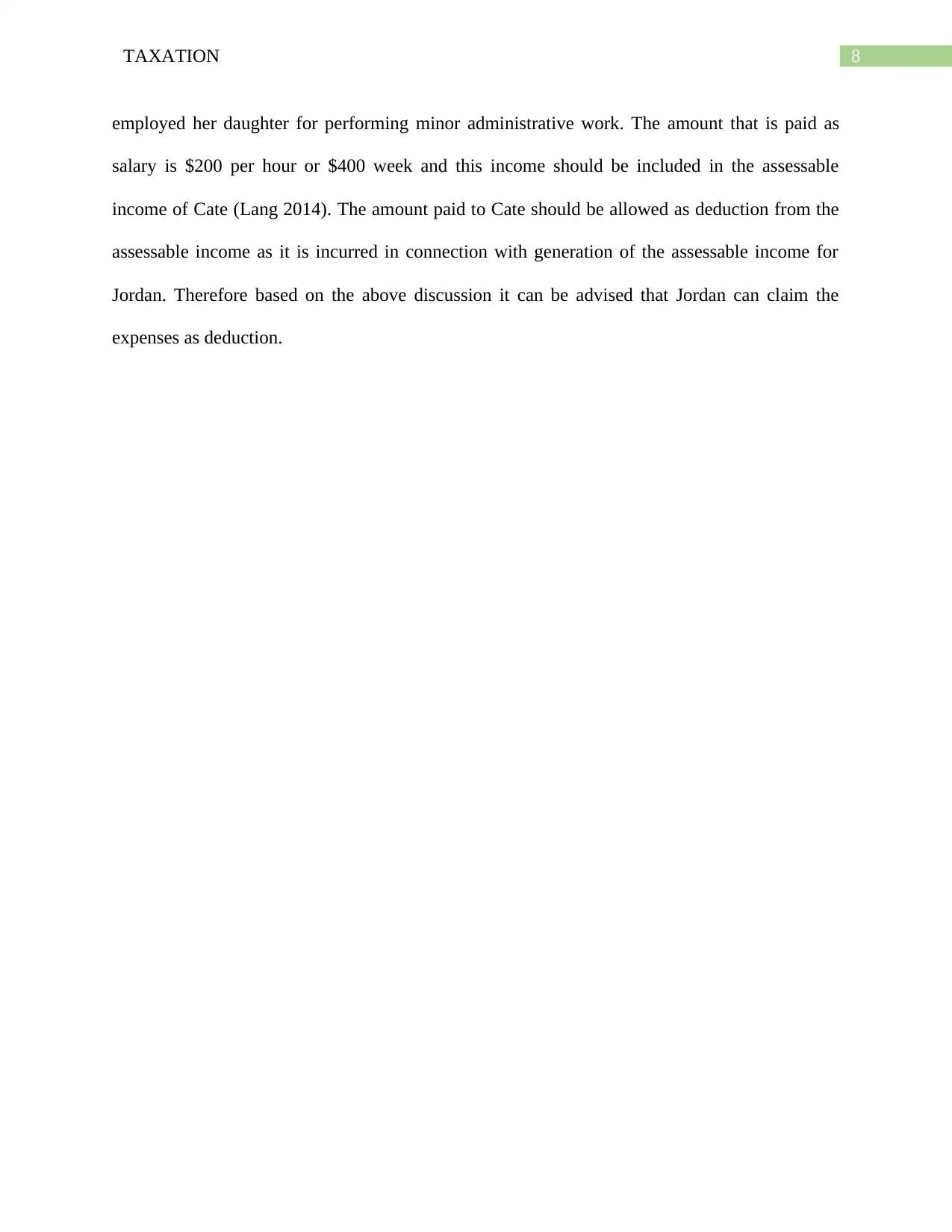
8TAXATION
employed her daughter for performing minor administrative work. The amount that is paid as
salary is $200 per hour or $400 week and this income should be included in the assessable
income of Cate (Lang 2014). The amount paid to Cate should be allowed as deduction from the
assessable income as it is incurred in connection with generation of the assessable income for
Jordan. Therefore based on the above discussion it can be advised that Jordan can claim the
expenses as deduction.
employed her daughter for performing minor administrative work. The amount that is paid as
salary is $200 per hour or $400 week and this income should be included in the assessable
income of Cate (Lang 2014). The amount paid to Cate should be allowed as deduction from the
assessable income as it is incurred in connection with generation of the assessable income for
Jordan. Therefore based on the above discussion it can be advised that Jordan can claim the
expenses as deduction.
⊘ This is a preview!⊘
Do you want full access?
Subscribe today to unlock all pages.

Trusted by 1+ million students worldwide
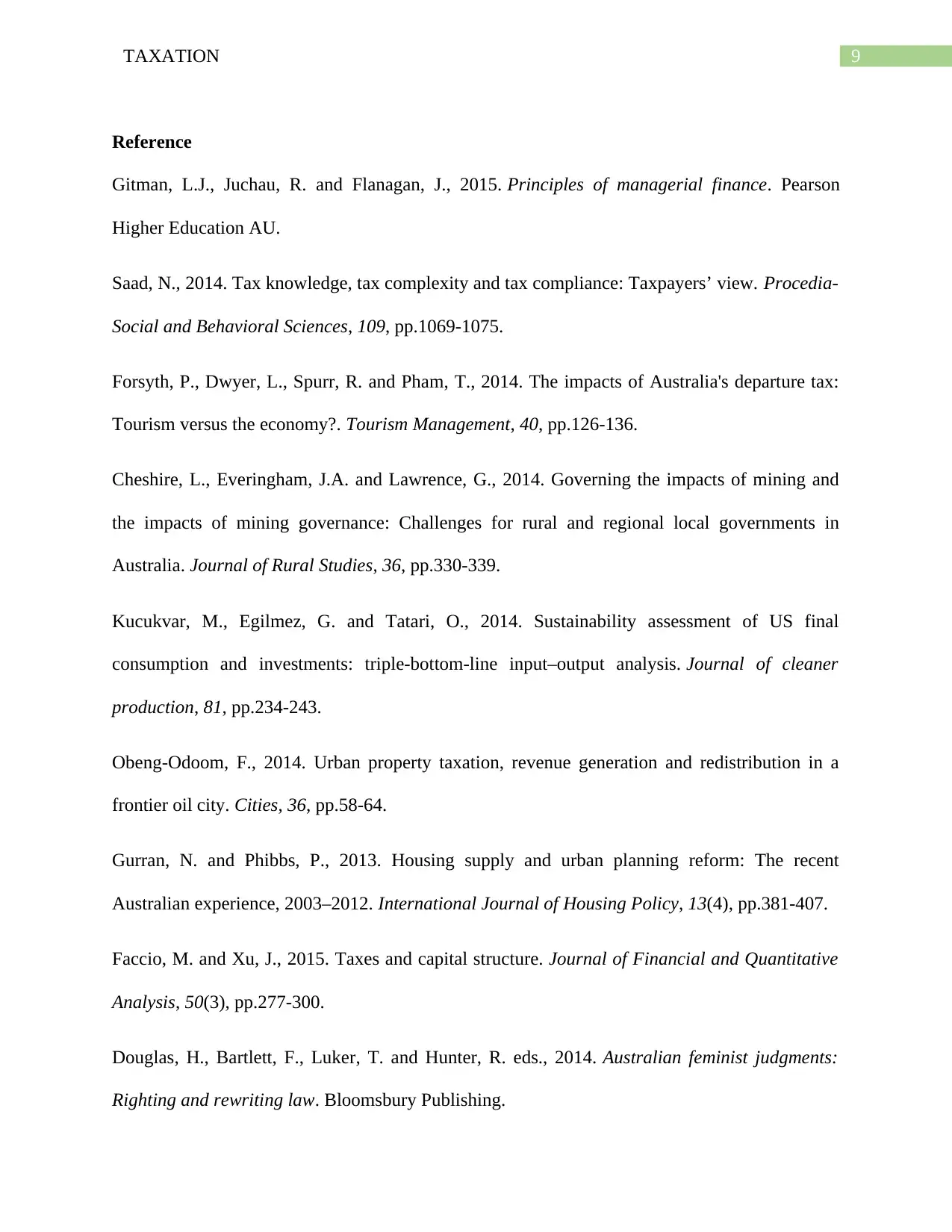
9TAXATION
Reference
Gitman, L.J., Juchau, R. and Flanagan, J., 2015. Principles of managerial finance. Pearson
Higher Education AU.
Saad, N., 2014. Tax knowledge, tax complexity and tax compliance: Taxpayers’ view. Procedia-
Social and Behavioral Sciences, 109, pp.1069-1075.
Forsyth, P., Dwyer, L., Spurr, R. and Pham, T., 2014. The impacts of Australia's departure tax:
Tourism versus the economy?. Tourism Management, 40, pp.126-136.
Cheshire, L., Everingham, J.A. and Lawrence, G., 2014. Governing the impacts of mining and
the impacts of mining governance: Challenges for rural and regional local governments in
Australia. Journal of Rural Studies, 36, pp.330-339.
Kucukvar, M., Egilmez, G. and Tatari, O., 2014. Sustainability assessment of US final
consumption and investments: triple-bottom-line input–output analysis. Journal of cleaner
production, 81, pp.234-243.
Obeng-Odoom, F., 2014. Urban property taxation, revenue generation and redistribution in a
frontier oil city. Cities, 36, pp.58-64.
Gurran, N. and Phibbs, P., 2013. Housing supply and urban planning reform: The recent
Australian experience, 2003–2012. International Journal of Housing Policy, 13(4), pp.381-407.
Faccio, M. and Xu, J., 2015. Taxes and capital structure. Journal of Financial and Quantitative
Analysis, 50(3), pp.277-300.
Douglas, H., Bartlett, F., Luker, T. and Hunter, R. eds., 2014. Australian feminist judgments:
Righting and rewriting law. Bloomsbury Publishing.
Reference
Gitman, L.J., Juchau, R. and Flanagan, J., 2015. Principles of managerial finance. Pearson
Higher Education AU.
Saad, N., 2014. Tax knowledge, tax complexity and tax compliance: Taxpayers’ view. Procedia-
Social and Behavioral Sciences, 109, pp.1069-1075.
Forsyth, P., Dwyer, L., Spurr, R. and Pham, T., 2014. The impacts of Australia's departure tax:
Tourism versus the economy?. Tourism Management, 40, pp.126-136.
Cheshire, L., Everingham, J.A. and Lawrence, G., 2014. Governing the impacts of mining and
the impacts of mining governance: Challenges for rural and regional local governments in
Australia. Journal of Rural Studies, 36, pp.330-339.
Kucukvar, M., Egilmez, G. and Tatari, O., 2014. Sustainability assessment of US final
consumption and investments: triple-bottom-line input–output analysis. Journal of cleaner
production, 81, pp.234-243.
Obeng-Odoom, F., 2014. Urban property taxation, revenue generation and redistribution in a
frontier oil city. Cities, 36, pp.58-64.
Gurran, N. and Phibbs, P., 2013. Housing supply and urban planning reform: The recent
Australian experience, 2003–2012. International Journal of Housing Policy, 13(4), pp.381-407.
Faccio, M. and Xu, J., 2015. Taxes and capital structure. Journal of Financial and Quantitative
Analysis, 50(3), pp.277-300.
Douglas, H., Bartlett, F., Luker, T. and Hunter, R. eds., 2014. Australian feminist judgments:
Righting and rewriting law. Bloomsbury Publishing.
Paraphrase This Document
Need a fresh take? Get an instant paraphrase of this document with our AI Paraphraser
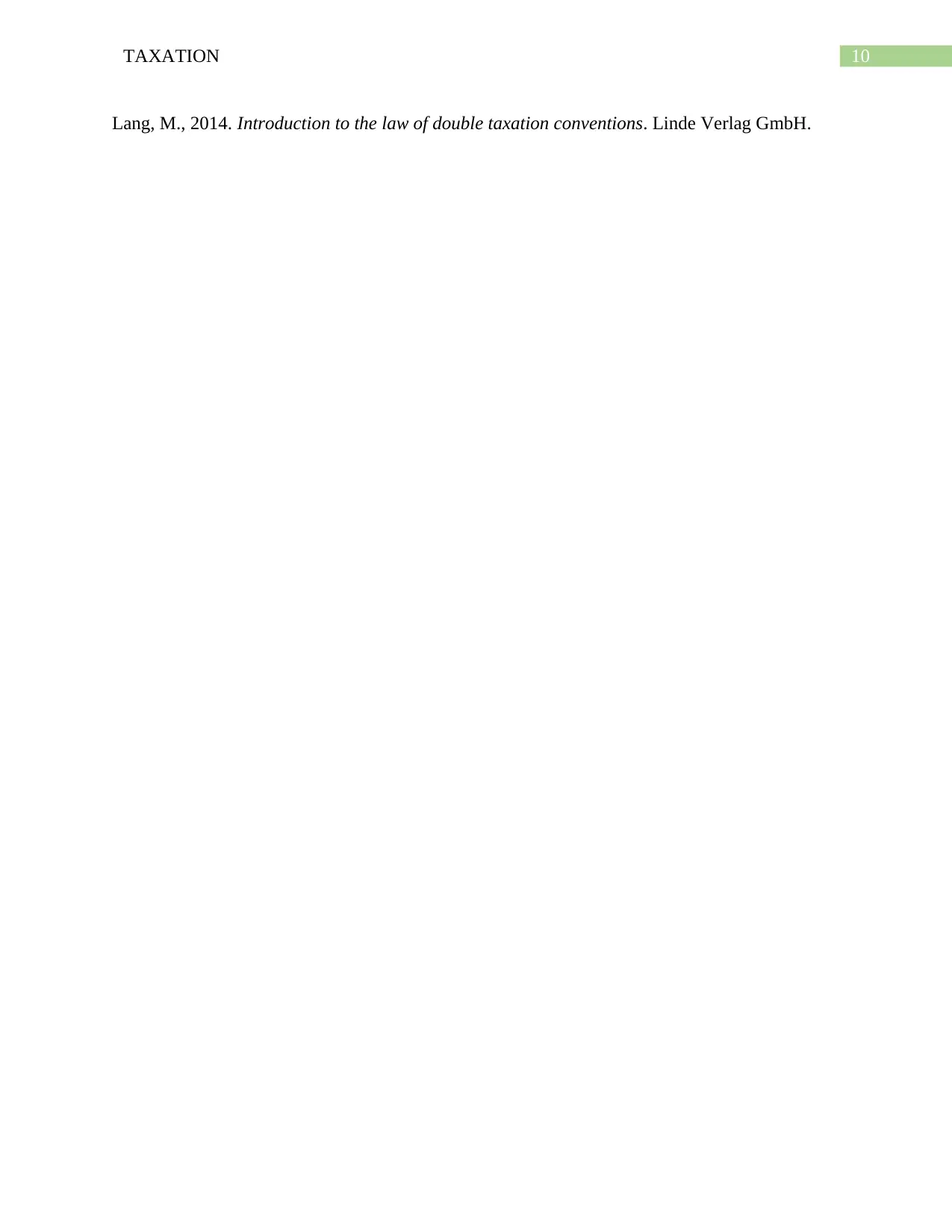
10TAXATION
Lang, M., 2014. Introduction to the law of double taxation conventions. Linde Verlag GmbH.
Lang, M., 2014. Introduction to the law of double taxation conventions. Linde Verlag GmbH.
1 out of 11
Related Documents
Your All-in-One AI-Powered Toolkit for Academic Success.
+13062052269
info@desklib.com
Available 24*7 on WhatsApp / Email
![[object Object]](/_next/static/media/star-bottom.7253800d.svg)
Unlock your academic potential
Copyright © 2020–2025 A2Z Services. All Rights Reserved. Developed and managed by ZUCOL.





